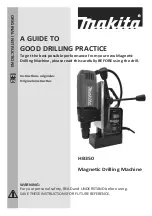
3
English
When the reverse selector is pushed in, the bit rotates
counterclockwise.
MOUNTING AND REMOVING THE BIT
See Figure 4.
Insert the drill bit into the chuck as far as the plain part
of its shank will go.
Tighten the chuck securely by rotating the chuck head
in a clockwise direction.
The bit can be removed by rotating the chuck in a
counterclockwise direction.
CHANGING BETWEEN DRILLING AND IMPACT DRILL-
ING MODE
See Figure 5.
The drilling mode shift knob for changing between
the drilling mode and impact drilling mode is positioned on
the top of the tool.
DRILLING MODE:
Shift the knob to the "
" and
showing "
" symbol for drilling.
IMPACT DRILLING MODE:
Shift the knob to the "
"
and showing "
" symbol for impact drilling.
OPERATING
Never cover the air vents since they must always be
open for proper motor cooling.
DRILLING IN WOOD
To prevent ugly splits around the drill hole on the reverse
side of the workpiece, put a piece of scrap timber under
the work piece.
DRILLING IN METAL
Metals such as steel, brass, aluminum sheets, stainless
steel, and pipe may also be drilled. Mark the point to be
drilled with a nail or punch.
Do not use impact drilling mode on these materials.
DRILLING IN CONCRETE
Stone and masonry are generally drilled in the impact
drilling mode.
When drilling in delicate materials such as wall tiles, it is
essential to start with ordinary drilling and, once the tile is
pierced, to continue with impact drilling.
In deep bore holes the drill bit should be pulled out
occasionally in order to remove the debris from the drill
and hole.
AUXILIARY HANDLE AND DEPTH GAUGE
See Figure 6.
Auxiliary handle
The auxiliary handle can be rotated 360º.
Loosen the handle grip by turning in direction, and tighten
it at an easy to use position by turning the grip in direction.
Depth gauge
Holes of a fi xed depth can be accurately bored by using
the depth gauge.
The depth of the hole will be the distance from the end of
the bit to the end of the depth gauge.
By turning the handle grip in direction, the depth gauge
can be released and the depth adjusted. After adjusting
the depth, fi x the depth gauge again by turning the handle
grip in direction.
Recommendation: Always be supplied via a residual
current device with a rated residual current of 30 mA or
less.
LIVE TOOL INDICATOR
This tool features a live tool indicator which illuminates as
soon as the tool is connected to the supply. This warns the
user that the tool is connected and will operate when the
switch is pressed.
MAINTENANCE
After use, check the tool to make sure that it is in good
condition. It is recommended that you take this tool to a
RYOBI authorised service center for a thorough cleaning
and lubrication at least once a year.
Do not make any adjustments while the motor is in
motion. Always disconnect the power cord from
the power supply before changing removable or
consumable parts (blade, bit, etc.), Lubricating or
working on the unit.
WARNING
To ensure safety and reliability, all repairs should be
performed by an authorised service center or other
qualifi ed service organisation.
Save these instructions for future reference.
SYMBOL
Safety Alert
V
Volts
Hz
Hertz
Alternating Current
W
Watts



























